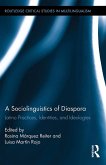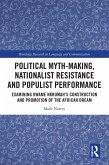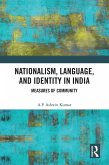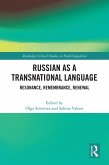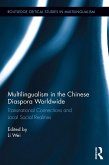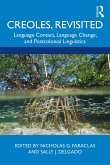Language, Home, and Belonging in Migratory Contexts (eBook, PDF)
The Case of Camfranglais


Alle Infos zum eBook verschenken

Language, Home, and Belonging in Migratory Contexts (eBook, PDF)
The Case of Camfranglais
- Format: PDF
- Merkliste
- Auf die Merkliste
- Bewerten Bewerten
- Teilen
- Produkt teilen
- Produkterinnerung
- Produkterinnerung

Hier können Sie sich einloggen

Bitte loggen Sie sich zunächst in Ihr Kundenkonto ein oder registrieren Sie sich bei bücher.de, um das eBook-Abo tolino select nutzen zu können.
This book presents a study of the role and functions of Camfranglais (CFrA) for diasporic Cameroonians living in the West, showcasing how closely language relates to identity and the role CFrA plays in negotiations of 'home' and 'belonging' for these diasporic Cameroonians.
Mbassi Manga adopts an integrated approach, bringing together the lenses of Critical Discourse Analysis and Linguistic Ethnography to the analysis of data on Camfranglais (CFrA), a hybrid urban language form from Cameroon that combines elements of French, English, Pidgin English, and Cameroonian vernaculars. Drawn from a…mehr
- Geräte: PC
- mit Kopierschutz
- eBook Hilfe
- Größe: 19.34MB
![Language, Home, and Belonging in Migratory Contexts (eBook, ePUB) Language, Home, and Belonging in Migratory Contexts (eBook, ePUB)]() Constance Mbassi MangaLanguage, Home, and Belonging in Migratory Contexts (eBook, ePUB)39,95 €
Constance Mbassi MangaLanguage, Home, and Belonging in Migratory Contexts (eBook, ePUB)39,95 €![A Sociolinguistics of Diaspora (eBook, PDF) A Sociolinguistics of Diaspora (eBook, PDF)]() A Sociolinguistics of Diaspora (eBook, PDF)48,95 €
A Sociolinguistics of Diaspora (eBook, PDF)48,95 €![Political Myth-making, Nationalist Resistance and Populist Performance (eBook, PDF) Political Myth-making, Nationalist Resistance and Populist Performance (eBook, PDF)]() Mark NarteyPolitical Myth-making, Nationalist Resistance and Populist Performance (eBook, PDF)39,95 €
Mark NarteyPolitical Myth-making, Nationalist Resistance and Populist Performance (eBook, PDF)39,95 €![Nationalism, Language, and Identity in India (eBook, PDF) Nationalism, Language, and Identity in India (eBook, PDF)]() A P Ashwin KumarNationalism, Language, and Identity in India (eBook, PDF)41,95 €
A P Ashwin KumarNationalism, Language, and Identity in India (eBook, PDF)41,95 €![Russian as a Transnational Language (eBook, PDF) Russian as a Transnational Language (eBook, PDF)]() Russian as a Transnational Language (eBook, PDF)42,95 €
Russian as a Transnational Language (eBook, PDF)42,95 €![Multilingualism in the Chinese Diaspora Worldwide (eBook, PDF) Multilingualism in the Chinese Diaspora Worldwide (eBook, PDF)]() Multilingualism in the Chinese Diaspora Worldwide (eBook, PDF)48,95 €
Multilingualism in the Chinese Diaspora Worldwide (eBook, PDF)48,95 €![Creoles, Revisited (eBook, PDF) Creoles, Revisited (eBook, PDF)]() Creoles, Revisited (eBook, PDF)38,95 €
Creoles, Revisited (eBook, PDF)38,95 €-
-
-
Mbassi Manga adopts an integrated approach, bringing together the lenses of Critical Discourse Analysis and Linguistic Ethnography to the analysis of data on Camfranglais (CFrA), a hybrid urban language form from Cameroon that combines elements of French, English, Pidgin English, and Cameroonian vernaculars. Drawn from a discussion on interviewees' accounts of the place and value of language in their life trajectories, and markers of identity, 'home' and 'belonging' in Facebook chats, the data analysis highlights CFrA's symbolic value and its role as an expression of a diasporic Cameroonian identity. The book concludes on the place and importance of non-official language use and other intracommunity cultural practices in the lived experiences of so-called migrants, as tools promoting well-being and positive integration in Western host societies.
This book will be of interest to scholars in Sociolinguistics, Linguistic Anthropology, Discourse Analysis, and Decolonial Studies.
Dieser Download kann aus rechtlichen Gründen nur mit Rechnungsadresse in A, B, BG, CY, CZ, D, DK, EW, E, FIN, F, GR, HR, H, IRL, I, LT, L, LR, M, NL, PL, P, R, S, SLO, SK ausgeliefert werden.
- Produktdetails
- Verlag: Taylor & Francis eBooks
- Seitenzahl: 280
- Erscheinungstermin: 10. Juni 2025
- Englisch
- ISBN-13: 9781040336380
- Artikelnr.: 74208436
- Verlag: Taylor & Francis eBooks
- Seitenzahl: 280
- Erscheinungstermin: 10. Juni 2025
- Englisch
- ISBN-13: 9781040336380
- Artikelnr.: 74208436
- Herstellerkennzeichnung Die Herstellerinformationen sind derzeit nicht verfügbar.
List of figures
List of tables
Transcription conventions
Chapter 1 - Introduction and background
1.1 Introduction
1.2 What do we call Camfranglais?
1.3 My personal interest in CFrA
1.3.1 My relationship to CFrA and other non-standard codes in my repertoire
1.3.2 Reasons that led me to research CFrA
1.4 Background
1.4.1 Colonial history & the link with CFrA
1.4.2 How decoloniality fits in
1.4.3 CFrA in the diaspora
1.4.4 Relevance of the topic
1.4.5 Research question
1.4.6 Ontological and epistemological position
1.4.7 Theoretical framework
1.4.8 Overview of indexical transformations undergone by CFrA in this
context
1.5 Value and usefulness of the interdisciplinary lens to this topic
1.5.1 Introduction
1.5.2 (Linguistic) Ethnography
1.5.3 Online/digital ethnography
1.5.3.1 Introduction
1.5.3.2 Nomenclature
1.5.3.3 The online field, its context, and privacy
1.5.3.4 Insights from relevant online ethnographies
1.5.4 Critical Discourse Analysis
1.5.5 Decolonial approaches to CDA
1.5.6 Combining LE & CDA
1.5.7 Key points on data collection (on- and offline)
1.5.8 Life narratives as data
1.5.9 Researcher's position and reflexivity
1.5.10 Data analysis: overview
1.6 Conclusion
Chapter 2 - Key concepts
2.1 Theorising Cameroonian-ness
2.1.1 Diaspora
2.1.2 The deconstruction of diasporic Cameroonian-ness
2.2 Community
2.3 'Home' and 'belonging', identity, and the migratory experience
2.3.1 ('Home' and) Belonging
2.3.2 Identity
2.3.3 Migratory experience
2.4 The functions of language
2.5 Translanguaging and its relevance to the project
2.6 Conclusion
Chapter 3 - Historical and socioeconomic context
3.1 From colonial era to independence
3.2 Language ideologies of the new Cameroonian state
3.2.1 From independence to the late 1980s
3.2.2 From the 1990s onward
3.2.3 Practical example: Camfranglais in pop culture
3.3 Main trends in the study of CFrA
3.3.1 Introduction
3.3.2 Trends in the study of CFrA: late 1990s to mid-2000s
3.3.2.1 CFrA as a linguistic system
3.3.2.2 CFrA and other registers
3.3.2.3 CFrA as an unstable register
3.3.2.4 CFrA and official language ideologies
3.3.2.5 CFrA as a sociolinguistic asset
3.3.3 Trends in the study of CFrA: mid- to late 2000s onward
3.3.3.1 Socioeconomic context of emergence of CFrA
3.3.3.2 CFrA as a language practice
3.3.3.3 CFrA and the diaspora
3.3.3.4 CFrA and identity
3.3.3.5 'Home' and 'belonging' in previous studies about CFrA
3.4 Conclusion
Chapter 4 - Skype conversations: narratives and diasporic identities
4.1 Introduction
4.2 The conversations
4.3 Brief vignettes of participants
4.3.1. Adam
4.3.2 Freddy
4.3.3 Lovely
4.3.4 Craig
4.3.5 Thalia
4.3.6 Manuela
4.3.7 Trish
4.3.8 Boris
4.3.9 Conclusion
4.4 Analysis: introduction
4.4.1 Participants' backgrounds and their impact on practices
4.4.2 Socioeconomic background
4.4.3 Age and time of arrival
4.5 Themes emerging from the conversations
4.5.1 Language and identity
4.5.2 Frenchness and Cameroonian-ness
4.5.3 Language and 'race'
4.5.4 Language ideologies about CFrA
4.5.5 'Home' and 'belonging'
4.5.6 Insights from the conversations
4.6 Conclusion
Chapter 5 - Facebook Group: an online community built around CFrA
5.1 Introduction
5.2 Overview of Facebook features and their impact on the data
5.2.1 Affordances of participation
5.2.2 Affordances of space
5.2.3 Affordances of personal expression
5.2.4 Affordances of connection
5.2.5 Impact of Facebook features on the project
5.3 General description of the group
5.3.1 Introduction
5.3.2 Organisation of the group
5.3.3 Engaging with the group
5.3.4 Data selection and download
5.4 Activity in the group
5.4.1 Introduction
5.4.2 Member interaction
5.5 Analysis: introduction
5.5.1 Overall content and style
5.6 Selected cases and themes
5.6.1 Diasporic migrant identity
5.6.1.1 Analysis
5.6.2 Community-building
5.6.2.1 Analysis
5.6.3 Cameroonian identity and patriotism
5.6.3.1 Prince
5.6.3.1.1 Analysis
5.6.3.2 Tebo
5.6.3.2.1 Analysis
5.6.4 Metadiscourses about CFrA
5.6.4.1 Analysis
5.6.5 Insights from the Facebook chats
5.7 Conclusion
Chapter 6 - Findings and conclusion
6.1 Introduction
6.2 Overall findings
6.3 Global significance of the case study
6.3.1 Links with the Sociolinguistics of Migration
6.3.2 Links with the (updated) Sociolinguistics of Diaspora
6.3.3 Links with postcolonial theories
6.3.4 Why and why now? Timeliness and relevance
6.4 Limitations
6.5 Further areas of research
6.6 Final comments
Appendix
Index
List of figures
List of tables
Transcription conventions
Chapter 1 - Introduction and background
1.1 Introduction
1.2 What do we call Camfranglais?
1.3 My personal interest in CFrA
1.3.1 My relationship to CFrA and other non-standard codes in my repertoire
1.3.2 Reasons that led me to research CFrA
1.4 Background
1.4.1 Colonial history & the link with CFrA
1.4.2 How decoloniality fits in
1.4.3 CFrA in the diaspora
1.4.4 Relevance of the topic
1.4.5 Research question
1.4.6 Ontological and epistemological position
1.4.7 Theoretical framework
1.4.8 Overview of indexical transformations undergone by CFrA in this
context
1.5 Value and usefulness of the interdisciplinary lens to this topic
1.5.1 Introduction
1.5.2 (Linguistic) Ethnography
1.5.3 Online/digital ethnography
1.5.3.1 Introduction
1.5.3.2 Nomenclature
1.5.3.3 The online field, its context, and privacy
1.5.3.4 Insights from relevant online ethnographies
1.5.4 Critical Discourse Analysis
1.5.5 Decolonial approaches to CDA
1.5.6 Combining LE & CDA
1.5.7 Key points on data collection (on- and offline)
1.5.8 Life narratives as data
1.5.9 Researcher's position and reflexivity
1.5.10 Data analysis: overview
1.6 Conclusion
Chapter 2 - Key concepts
2.1 Theorising Cameroonian-ness
2.1.1 Diaspora
2.1.2 The deconstruction of diasporic Cameroonian-ness
2.2 Community
2.3 'Home' and 'belonging', identity, and the migratory experience
2.3.1 ('Home' and) Belonging
2.3.2 Identity
2.3.3 Migratory experience
2.4 The functions of language
2.5 Translanguaging and its relevance to the project
2.6 Conclusion
Chapter 3 - Historical and socioeconomic context
3.1 From colonial era to independence
3.2 Language ideologies of the new Cameroonian state
3.2.1 From independence to the late 1980s
3.2.2 From the 1990s onward
3.2.3 Practical example: Camfranglais in pop culture
3.3 Main trends in the study of CFrA
3.3.1 Introduction
3.3.2 Trends in the study of CFrA: late 1990s to mid-2000s
3.3.2.1 CFrA as a linguistic system
3.3.2.2 CFrA and other registers
3.3.2.3 CFrA as an unstable register
3.3.2.4 CFrA and official language ideologies
3.3.2.5 CFrA as a sociolinguistic asset
3.3.3 Trends in the study of CFrA: mid- to late 2000s onward
3.3.3.1 Socioeconomic context of emergence of CFrA
3.3.3.2 CFrA as a language practice
3.3.3.3 CFrA and the diaspora
3.3.3.4 CFrA and identity
3.3.3.5 'Home' and 'belonging' in previous studies about CFrA
3.4 Conclusion
Chapter 4 - Skype conversations: narratives and diasporic identities
4.1 Introduction
4.2 The conversations
4.3 Brief vignettes of participants
4.3.1. Adam
4.3.2 Freddy
4.3.3 Lovely
4.3.4 Craig
4.3.5 Thalia
4.3.6 Manuela
4.3.7 Trish
4.3.8 Boris
4.3.9 Conclusion
4.4 Analysis: introduction
4.4.1 Participants' backgrounds and their impact on practices
4.4.2 Socioeconomic background
4.4.3 Age and time of arrival
4.5 Themes emerging from the conversations
4.5.1 Language and identity
4.5.2 Frenchness and Cameroonian-ness
4.5.3 Language and 'race'
4.5.4 Language ideologies about CFrA
4.5.5 'Home' and 'belonging'
4.5.6 Insights from the conversations
4.6 Conclusion
Chapter 5 - Facebook Group: an online community built around CFrA
5.1 Introduction
5.2 Overview of Facebook features and their impact on the data
5.2.1 Affordances of participation
5.2.2 Affordances of space
5.2.3 Affordances of personal expression
5.2.4 Affordances of connection
5.2.5 Impact of Facebook features on the project
5.3 General description of the group
5.3.1 Introduction
5.3.2 Organisation of the group
5.3.3 Engaging with the group
5.3.4 Data selection and download
5.4 Activity in the group
5.4.1 Introduction
5.4.2 Member interaction
5.5 Analysis: introduction
5.5.1 Overall content and style
5.6 Selected cases and themes
5.6.1 Diasporic migrant identity
5.6.1.1 Analysis
5.6.2 Community-building
5.6.2.1 Analysis
5.6.3 Cameroonian identity and patriotism
5.6.3.1 Prince
5.6.3.1.1 Analysis
5.6.3.2 Tebo
5.6.3.2.1 Analysis
5.6.4 Metadiscourses about CFrA
5.6.4.1 Analysis
5.6.5 Insights from the Facebook chats
5.7 Conclusion
Chapter 6 - Findings and conclusion
6.1 Introduction
6.2 Overall findings
6.3 Global significance of the case study
6.3.1 Links with the Sociolinguistics of Migration
6.3.2 Links with the (updated) Sociolinguistics of Diaspora
6.3.3 Links with postcolonial theories
6.3.4 Why and why now? Timeliness and relevance
6.4 Limitations
6.5 Further areas of research
6.6 Final comments
Appendix
Index


